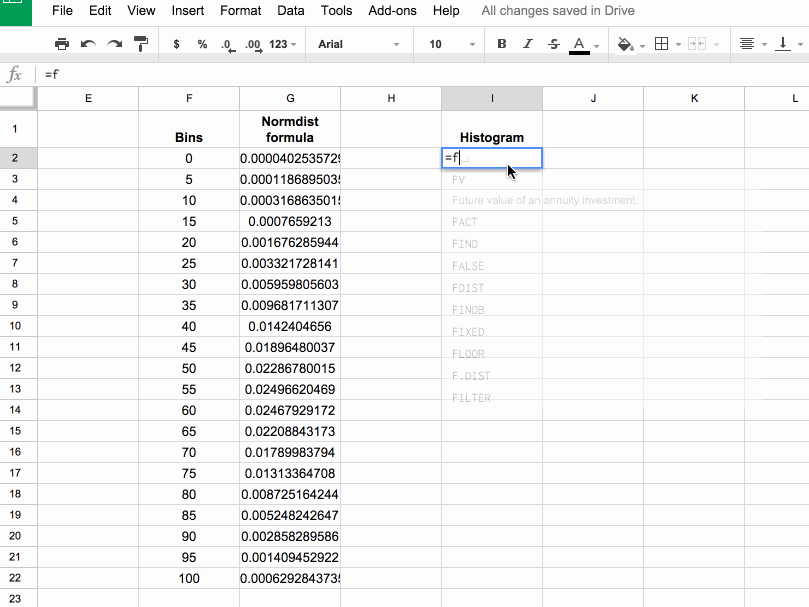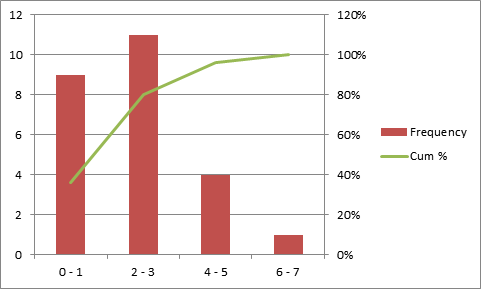
- Excel For Mac Relative Frequency Histogram Template
- Excel For Mac Relative Frequency Histogram Example
- Excel For Mac Relative Frequency Histogram
Frequency Distributions and Histograms
A frequency distribution is often used to group quantitative data. Data values are grouped into classes of equal widths. The smallest and largest observations in each class are called class limits, while class boundaries are individual values chosen to separate classes (often being the midpoints between upper and lower class limits of adjacent classes).
For example, the table below gives a frequency distribution for the following data:
$$textrm{Data values: } 11, 13, 15, 15, 18, 20, 21, 22, 24, 24, 25, 25, 25, 26, 28, 29, 29, 34$$$$begin{array}{c|c|c}textrm{Class Limits} & textrm{Class Boundaries} & textrm{Frequency}hline10 - 14 & 9.5 - 14.5 & 2hline15 - 19 & 14.5 - 19.5 & 3hline20 - 24 & 19.5 - 24.5 & 5hline25 - 29 & 24.5 - 29.5 & 7hline30 - 34 & 29.5 - 34.5 & 1hlineend{array}$$Frequency distributions should typically have between 5 and 20 classes, all of equal width; be mutually exclusive; continuous; and exhaustive.One should use nice 'round' numbers for your class limits as long as there is not a compelling reason to avoid doing so. It will make your frequency distribution easier to read. For example, if your data starts with 43, 46, 48, 48, 52, 57, 58, ... you might pick a lower class limit of 40 and a class width of 5 (provided that a reasonable number of classes resulted)
A relative frequency distribution is very similar, except instead of reporting how many data values fall in a class, they report the fraction of data values that fall in a class. These are called relative frequencies and can be given as fractions, decimals, or percents.
A cumulative frequency distribution is another variant of a frequency distribution. Here, instead of reporting how many data values fall in some class, they report how many data values are contained in either that class or any class to its left.
Calculating descriptive statistics such as mean, median, and variance is easy, since Excel has functions for this purpose. Let’s look at something a little more complicated but a necessary tool in the statistician’s toolbox, the frequency distribution and its graphical comrade, the histogram. Creating a Histogram using Microsoft Excel. In this case, it’s A2 and B2. Then, while still holding down Shift, hold Ctrl (Command for Mac) + Arrow Down. After you highlight the data, click ‘Insert’ from the tab list. After that, click on the ‘Insert Statistic Chart’ and select Histogram’. Now you have a histogram based on the data set.
The below table compares the values seen in a frequency distribution, a relative frequency distribution, and a cumulative frequency distribution, for the following sequence of dice rolls$$textrm{Dice Rolls: } 7, 6, 7, 6, 7, 4, 4, 6, 10, 5, 6, 11, 4, 8, 2, 9, 6, 5, 3, 8, 3, 3, 12, 9, 10, 7, 6, 7, 4, 6$$$$begin{array}{c|c|c}textrm{Class Limits} & textrm{Class Boundaries} & textrm{Frequency} & textrm{Relative Frequency} & textrm{Cumulative Frequency}hline2 - 3 & 1.5 - 3.5 & 4 & 2/15 & 4hline4 - 5 & 3.5 - 5.5 & 6 & 1/5 & 10 hline6 - 7 & 5.5 - 7.5 & 12 & 2/5 & 22hline8 - 9 & 7.5 - 9.5 & 4 & 2/15 & 26hline10 - 11 & 9.5 - 11.5 & 3 & 1/10 & 29hline12 - 13 & 11.5 - 13.5 & 1 & 1/30 & 30end{array}$$
A frequency histogram is a graphical version of a frequency distribution where the width and position of rectangles are used to indicate the various classes, with the heights of those rectangles indicating the frequency with which data fell into the associated class, as the example below suggests.
Excel For Mac Relative Frequency Histogram Template
Frequency histograms should be labeled with either class boundaries (as shown below) or with class midpoints (in the middle of each rectangle).
One can, of course, similarly construct relative frequency and cumulative frequency histograms.
The purpose of these graphs is to 'see' the distribution of the data. When using a calculator or software to plot histograms, experiment with different choices for boundaries, subject to the above restrictions, to find out which graphical properties (modality, skewness or symmetry, outliers, etc...) persist and which are just spurious effects of a particular choice of boundaries. Then use the boundaries that best reveal these persistant properites.

Probability Histograms
A type of graph closely related to a frequency histogram is a probability histogram, which shows the probabilities associated with a probability distribution in a similar way.
Here, we have a rectangle for each value a random variable can assume, where the height of the rectangle indicates the probability of getting that associated value.
When the possible values the random variable can assume are consecutive integers, the left and right sides of the rectangles are taken to be the midpoints between these integers -- which forces them to all end in $0.5$. Additionally, the width of each rectangle is then $1$, which means that not only the height of the rectangle equals the probability of the corresponding value occurring, but the area of the rectangle does as well. (These observations become very important later when we apply a 'continuity correction' to approximate a discrete probability distribution with a continuous one.)
Make a Histogram in Microsoft Excel 2016 for Mac
A histogram displays the frequency values in a proportional graph.You're going to need some data to work with. Here's the data used in the example below.. Type this into a blank worksheet:
 Follow these steps to make a really great looking histogram.
Follow these steps to make a really great looking histogram.1. Select any cell within the range of cells that includes the data.
2. Click the Inserttab on the Ribbon.
3. In the Charts group on the Ribbon, click the Recommended Charts button.
4. Choose Clustered Column chart type.
5. Click once on any of the columns measuring Value. In this example, the Value row is represented by the taller columns. Little round 'handles' will appear on all of the columns to indicate they are selected. Your chart should look something like this with the Value measure selected:
6. Press the Delete key. Values no longer display and Frequency columns remain visible. Now your chart should look like this:
7. Next, we need to put the proper values in the x-axis. From the Chart Design tab of the Ribbon click the Select Data button. The Select Source Data dialog opens. If you don't see the Chart Design tab in the Ribbon, you clicked away from the chart. Click anywhere on your chart to activate the Chart Design tab.
8. Note that the Horizontal (Category) axis labels field in the dialog is blank. We need to fill this in. Click the little button to the right of the empty field.
9. Drag over the cell range that has your values, but do not include the data label. Then press the Return key. Using our example, you would select the range B2:H2. Excel fills in the dialog box for you, but you might have to click into the empty field to get the display to refresh.
10. Click the OK button to close the Source Data dialog box.
11. You can click on the Frequency label and press delete if you want to tidy things up. Your finished chart will look about like this:
If you're making a histogram for a course, your instructor may be anal-retentive. If you're unfortunate enough to have one of these ultra-picky types, you're not done yet. To make your teacher happy you'll have to get rid of the gaps between the bars.
Here are the additional steps to take:
12. Click once on any of the columns so that they are all selected.
13. Right-click on a column and choose Format Data Series from the pop-up menu. The Format Data Series pane will open.
14. In the Format Data Series pane, adjust the Gap width to 0%
15. Click the OK button.
Your chart should now look like this:
If you really want to impress your teacher, apply different formatting options. Here's the same chart after formatting was changed. Well, maybe this isn't better. I am sure you can do a better job!
Excel For Mac Relative Frequency Histogram Example
Alternative Methods for making histograms
Mike Middleton has a free add-in that makes Histograms:http://betterhistogram.betteraddins.com/free-download/
The Excel store has a free trial of a Javascript add-in called Data Bucket Chart. Here's how to try it:
1. On the Insert tab of the Ribbon click the Add-ins button
2. Click the Store button
3. Click into the Search field and type Histogram then press Return
4. Click the Buy button
5. Follow the instructions to add this add-in to your add-ins collection
